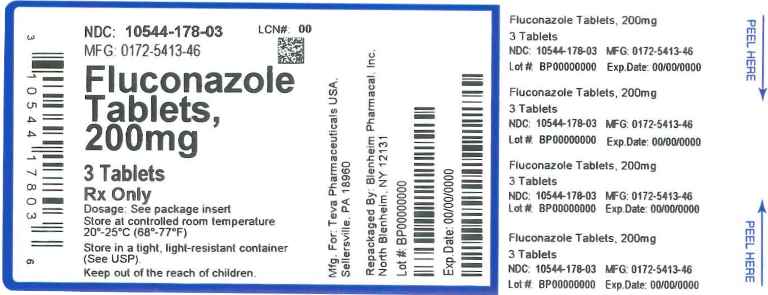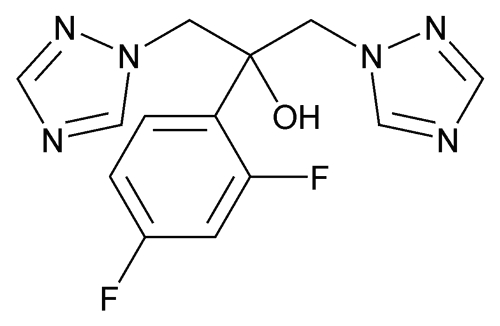Drug Catalog - Product Detail
FLUCONAZOLE TABLETS 100MG 100
| NDC | Mfr | Size | Str | Form |
|---|---|---|---|---|
| 00172-5411-60 | TEVA PHARMACEUTICALS USA | 100 | 100MG | TABLET |
PACKAGE FILES







Generic Name
Substance Name
Product Type
Route
Application Number
Description
DESCRIPTION Fluconazole, USP, the first of a new subclass of synthetic triazole antifungal agents, is available as tablets for oral administration. Fluconazole, USP is designated chemically as 2,4-Difluoro-1′,1′-bis(1H-1,2,4-triazol-1-ylmethyl) benzyl alcohol and has the following structural formula: C 13 H 12 F 2 N 6 O M.W. 306.27 Fluconazole, USP is a white crystalline solid which is slightly soluble in water and saline. Fluconazole Tablets USP, for oral administration, contain 50, 100, 150, or 200 mg of fluconazole, USP and have the following inactive ingredients: colloidal silicon dioxide, corn starch, croscarmellose sodium, FD&C red #40 aluminum lake, lactose monohydrate, magnesium stearate, microcrystalline cellulose, and talc. Structure
How Supplied
HOW SUPPLIED Fluconazole Tablets USP, 50 mg are available as pink, modified oval-shaped, unscored tablets, debossed “5410” on one side and “50” on the other side and packaged in bottles of 30 (NDC 0172-5410-46) and 100 (NDC 0172-5410-60) tablets. Fluconazole Tablets USP, 100 mg are available as pink, modified oval-shaped, unscored tablets, debossed “5411” on one side and “100” on the other side and packaged in bottles of 30 (NDC 0172-5411-46) and 100 (NDC 0172-5411-60) tablets. Fluconazole Tablets USP, 150 mg are available as pink, modified oval-shaped, unscored tablets, debossed “5412” on one side and “150” on the other side and packaged in a carton of 12 (NDC 0172-5412-11) unit-of-use cards of 1 tablet. Fluconazole Tablets USP, 200 mg are available as pink, modified oval-shaped, unscored tablets, debossed “5413” on one side and “200” on the other side and packaged in bottles of 30 (NDC 0172-5413-46) and 100 (NDC 0172-5413-60) tablets. Store at 20˚ to 25˚C (68˚ to 77˚F) [See USP Controlled Room Temperature]. Dispense in a tight container as defined in the USP, with a child resistant closure (as required). KEEP THIS AND ALL MEDICATIONS OUT OF THE REACH OF CHILDREN. Imprint1 Imprint2 Imprint3 Imprint4
Indications & Usage
INDICATIONS AND USAGE Fluconazole Tablets USP are indicated for the treatment of: Vaginal candidiasis (vaginal yeast infections due to Candida ). Oropharyngeal and esophageal candidiasis. In open noncomparative studies of relatively small numbers of patients, fluconazole was also effective for the treatment of Candida urinary tract infections, peritonitis, and systemic Candida infections including candidemia, disseminated candidiasis, and pneumonia. Cryptococcal meningitis. Before prescribing Fluconazole Tablets USP for AIDS patients with cryptococcal meningitis, please see CLINICAL STUDIES section. Studies comparing fluconazole to amphotericin B in non-HIV infected patients have not been conducted. Prophylaxis Fluconazole Tablets USP are also indicated to decrease the incidence of candidiasis in patients undergoing bone marrow transplantation who receive cytotoxic chemotherapy and/or radiation therapy. Specimens for fungal culture and other relevant laboratory studies (serology, histopathology) should be obtained prior to therapy to isolate and identify causative organisms. Therapy may be instituted before the results of the cultures and other laboratory studies are known; however, once these results become available, anti-infective therapy should be adjusted accordingly.
Dosage and Administration
DOSAGE AND ADMINISTRATION Dosage and Administration in Adults Single Dose Vaginal Candidiasis The recommended dosage of fluconazole for vaginal candidiasis is 150 mg as a single oral dose. Multiple Dose SINCE ORAL ABSORPTION IS RAPID AND ALMOST COMPLETE, THE DAILY DOSE OF FLUCONAZOLE IS THE SAME FOR ORAL AND INTRAVENOUS ADMINISTRATION. In general, a loading dose of twice the daily dose is recommended on the first day of therapy to result in plasma concentrations close to steady-state by the second day of therapy. The daily dose of fluconazole for the treatment of infections other than vaginal candidiasis should be based on the infecting organism and the patient’s response to therapy. Treatment should be continued until clinical parameters or laboratory tests indicate that active fungal infection has subsided. An inadequate period of treatment may lead to recurrence of active infection. Patients with AIDS and cryptococcal meningitis or recurrent oropharyngeal candidiasis usually require maintenance therapy to prevent relapse. Oropharyngeal Candidiasis The recommended dosage of fluconazole for oropharyngeal candidiasis is 200 mg on the first day, followed by 100 mg once daily. Clinical evidence of oropharyngeal candidiasis generally resolves within several days, but treatment should be continued for at least 2 weeks to decrease the likelihood of relapse. Esophageal Candidiasis The recommended dosage of fluconazole for esophageal candidiasis is 200 mg on the first day, followed by 100 mg once daily. Doses up to 400 mg/day may be used, based on medical judgment of the patient’s response to therapy. Patients with esophageal candidiasis should be treated for a minimum of three weeks and for at least two weeks following resolution of symptoms. Systemic Candida Infections For systemic Candida infections including candidemia, disseminated candidiasis, and pneumonia, optimal therapeutic dosage and duration of therapy have not been established. In open, noncomparative studies of small numbers of patients, doses of up to 400 mg daily have been used. Urinary Tract Infections and Peritonitis For the treatment of Candida urinary tract infections and peritonitis, daily doses of 50 to 200 mg have been used in open, noncomparative studies of small numbers of patients. Cryptococcal Meningitis The recommended dosage for treatment of acute cryptococcal meningitis is 400 mg on the first day, followed by 200 mg once daily. A dosage of 400 mg once daily may be used, based on medical judgment of the patient’s response to therapy. The recommended duration of treatment for initial therapy of cryptococcal meningitis is 10 to 12 weeks after the cerebrospinal fluid becomes culture negative. The recommended dosage of fluconazole for suppression of relapse of cryptococcal meningitis in patients with AIDS is 200 mg once daily. Prophylaxis in Patients Undergoing Bone Marrow Transplantation The recommended fluconazole daily dosage for the prevention of candidiasis in patients undergoing bone marrow transplantation is 400 mg, once daily. Patients who are anticipated to have severe granulocytopenia (less than 500 neutrophils per cu mm) should start fluconazole prophylaxis several days before the anticipated onset of neutropenia, and continue for 7 days after the neutrophil count rises above 1000 cells per cu mm. Dosage and Administration in Children The following dose equivalency scheme should generally provide equivalent exposure in pediatric and adult patients: Pediatric Patients Adults 3 mg/kg 100 mg 6 mg/kg 200 mg 12 Some older children may have clearances similar to that of adults. Absolute doses exceeding 600 mg/day are not recommended. mg/kg 400 mg Experience with fluconazole in neonates is limited to pharmacokinetic studies in premature newborns (see CLINICAL PHARMACOLOGY ). Based on the prolonged half-life seen in premature newborns (gestational age 26 to 29 weeks), these children, in the first two weeks of life, should receive the same dosage (mg/kg) as in older children, but administered every 72 hours. After the first two weeks, these children should be dosed once daily. No information regarding fluconazole pharmacokinetics in full-term newborns is available. Oropharyngeal Candidiasis The recommended dosage of fluconazole for oropharyngeal candidiasis in children is 6 mg/kg on the first day, followed by 3 mg/kg once daily. Treatment should be administered for at least 2 weeks to decrease the likelihood of relapse. Esophageal Candidiasis For the treatment of esophageal candidiasis, the recommended dosage of fluconazole in children is 6 mg/kg on the first day, followed by 3 mg/kg once daily. Doses up to 12 mg/kg/day may be used based on medical judgment of the patient’s response to therapy. Patients with esophageal candidiasis should be treated for a minimum of three weeks and for at least 2 weeks following the resolution of symptoms. Systemic Candida Infections For the treatment of candidemia and disseminated Candida infections, daily doses of 6 to 12 mg/kg/day have been used in an open, noncomparative study of a small number of children. Cryptococcal Meningitis For the treatment of acute cryptococcal meningitis, the recommended dosage is 12 mg/kg on the first day, followed by 6 mg/kg once daily. A dosage of 12 mg/kg once daily may be used, based on medical judgment of the patient’s response to therapy. The recommended duration of treatment for initial therapy of cryptococcal meningitis is 10 to 12 weeks after the cerebrospinal fluid becomes culture negative. For suppression of relapse of cryptococcal meningitis in children with AIDS, the recommended dose of fluconazole is 6 mg/kg once daily. Dosage in Patients With Impaired Renal Function Fluconazole is cleared primarily by renal excretion as unchanged drug. There is no need to adjust single dose therapy for vaginal candidiasis because of impaired renal function. In patients with impaired renal function who will receive multiple doses of fluconazole, an initial loading dose of 50 to 400 mg should be given. After the loading dose, the daily dose (according to indication) should be based on the following table: Creatinine Clearance (mL/min) Percent of Recommended Dose > 50 100% ≤ 50 (no dialysis) 50% Regular dialysis 100% after each dialysis Patients on regular dialysis should receive 100% of the recommended dose after each dialysis; on non-dialysis days, patients should receive a reduced dose according to their creatinine clearance. These are suggested dose adjustments based on pharmacokinetics following administration of multiple doses. Further adjustment may be needed depending upon clinical condition. When serum creatinine is the only measure of renal function available, the following formula (based on sex, weight, and age of the patient) should be used to estimate the creatinine clearance in adults: Males: Weight (kg) × (140 - age) 72 × serum creatinine (mg/100 mL) Females: 0.85 × above value Although the pharmacokinetics of fluconazole has not been studied in children with renal insufficiency, dosage reduction in children with renal insufficiency should parallel that recommended for adults. The following formula may be used to estimate creatinine clearance in children: K × linear length or height (cm) serum creatinine (mg/100 mL) (Where K = 0.55 for children older than 1 year and 0.45 for infants.) Administration Fluconazole is administered orally. Fluconazole can be taken with or without food.
